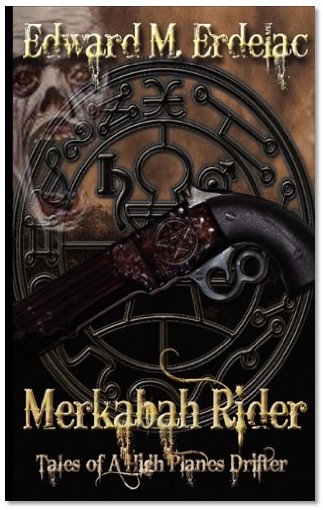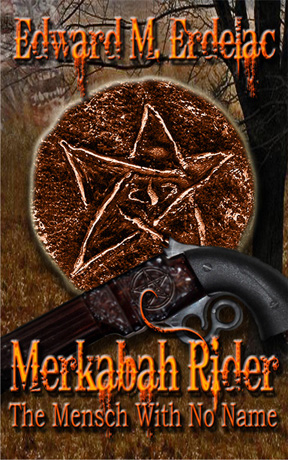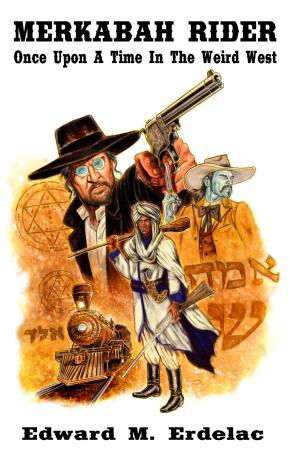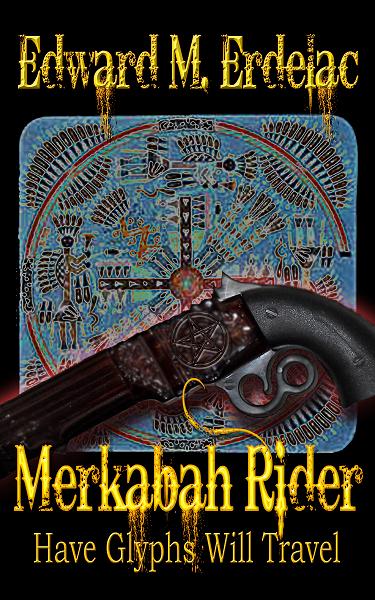Spaghetti Westerns Go Kaballah

 I’ve known Ed Erdelac from New Pulp circles, but had never read any of his fiction before. Ed is a very talented author who has determined to carve out his own niche in the familiar sub-genre of spaghetti westerns.
I’ve known Ed Erdelac from New Pulp circles, but had never read any of his fiction before. Ed is a very talented author who has determined to carve out his own niche in the familiar sub-genre of spaghetti westerns.
If one is to be accurate, spaghetti westerns were westerns of the 1960s and 1970s made by Italian filmmakers in Spain with international casts and international funding. They offered an avant garde spin on westerns which were gritty, realistic, bloody, and notably laconic in contrast to the traditional Hollywood westerns which mythologized America’s past. Since the mid-1960s, Hollywood has occasionally offered up their own imitation spaghetti westerns, right up to Quentin Tarantino’s acclaimed Django Unchained.
Enter: Ed Erdelac. Ed wasn’t the first author to translate spaghetti westerns to the printed page. Sergio Leone’s Dollars trilogy inspired a Man with No Name literary series in the 1960s. However, he is, to my knowledge, the first author to put a Jewish spin on this very stylish sub-genre. While there was a tongue-in-cheek Jewish spy series in the 1960s, Erdelac isn’t interested in writing a kitsch genre spoof like Sol Weinstein’s Agent Oy-Oy Seven series. The Merkabah Rider series is as deadly serious as it is eccentric and the dramatic tone makes all the difference to the book’s success.
The first title in Ed’s series for Damnation Books, Merkabah Rider: Tales of a High Planes Drifter collects four novellas concerning the 19th century Hasidic Jewish mystic turned gunslinger (think a kosher Pale Rider operating in reverse and you’re fairly close). The Rider is a Civil War veteran who set aside the ascetic life after his order was slaughtered to mete out a vigilante brand of justice, albeit with pangs of conscience. Making things more interesting, the Rider is a mystic who has mastered astral projection and is able to combat the preternatural forces that influence the evil that men do.

 The obvious thought is that this series should be adapted as a graphic novel with possible cinematic exploitation, but such thoughts do a disservice to Erdelac’s writing, which is sharp and incisive storytelling at its finest. The thrills are frequently pulpish in nature, but the depth of the prose is decidedly modern and literate in the best New Pulp tradition.
The obvious thought is that this series should be adapted as a graphic novel with possible cinematic exploitation, but such thoughts do a disservice to Erdelac’s writing, which is sharp and incisive storytelling at its finest. The thrills are frequently pulpish in nature, but the depth of the prose is decidedly modern and literate in the best New Pulp tradition.
Some may be put off by the large dollops of Jewish tradition and Yiddish words that Erdelac includes in the story. This is, simply, a knee-jerk reaction on the part of goyim who are uncomfortable with all things kosher. The truth is Erdelac’s world is just as accessible as Tolkien or Frank Herbert or any other master fantasist who sought to craft a realistic, if unfamiliar, world for the reader to believe the characters actually inhabit. For those, like me, who enjoy immersing themselves in such esoteric matters, Erdelac includes a glossary to help the reader feel they are entering a real world and not merely losing themselves in escapism.
The four novellas in the first volume form part of a larger narrative concerned with the apocalyptic End of Days and a quest for redemption for the Rider’s fallen master, Adon, who was responsible for the extermination of the Rider’s order.
The first novella, “Blood Libel,” concerns anti-semitism and child victimization in the wonderfully named Western mining town of Delirium Tremens, whose God-fearing residents allow their anger and fear to make the Jewish community of Little Jerusalem serve as the scapegoat for a heinous crime. As excellent as this tale is, the historical truth of Jewish people being labeled child-sacrificing Satanists by bigots is a shameful matter of historical record that has recurred for several centuries now.
The second novella, “The Dust Devils,” is concerned with intolerance and racial cleansing, but personifies such evil not in the form of a demon, but a mortal sorcerer who is a more powerful mage than the Rider himself. The real strength of the story is Erdelac’s dual threat of earth’s nature (in the form of the ravaging dust storm) and human nature, which combine to threaten the border town with extinction.
The third novella, “Hell’s Hired Gun,” is my personal favorite, primarily because the villain of the piece, Medgar Tooms, possesses undeniable similarities to the Rider. This well-written story grapples with the nature of the anti-hero that is essential to the spaghetti western genre.
The final story in the first collection, “The Nightjar Women,” deals directly with the mythological Lilith, the cursed unfaithful first wife of Adam, who consorted with demons to breed a race of monsters in Jewish apocryphal folklore. Erdelac’s decision to tie the witch queen in as a preternatural patron of a whorehouse is particularly inspired.
Yet again, I find myself enamored of another series by a talented writer richly deserving of greater exposure. I have not yet read the next three volumes in the series, but I strongly encourage readers to sample Merkabah Rider. New Pulp is quickly establishing itself as much more vital and original than its detractors would suggest and Ed Erdelac is at the head of the pack in changing that perception.
William Patrick Maynard was authorized to continue Sax Rohmer’s Fu Manchu thrillers beginning with The Terror of Fu Manchu (2009; Black Coat Press) and The Destiny of Fu Manchu (2012; Black Coat Press). The Triumph of Fu Manchu is scheduled for publication in June 2014.
This sounds awesome. I’ll buy a copy. Thanks for the heads up.